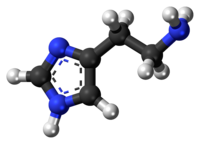
Photo from wikipedia
The bacterium Morganella morganii can produce the biogenic amines (BA) cadaverine, putrescine, and histamine in vitro and is responsible for high histamine concentrations in fish products. These BA can have… Click to show full abstract
The bacterium Morganella morganii can produce the biogenic amines (BA) cadaverine, putrescine, and histamine in vitro and is responsible for high histamine concentrations in fish products. These BA can have toxic effects upon ingestion and are undesired in food. The purpose of this study was to characterize the phenotype and genotype of 11 M. morganii isolated from cheese in regard to the BA formation. In addition, we investigated the phylogeny, trehalose fermentation ability, and antibiotic resistance of the cheese isolates. To do so, we sequenced their genomes using both long and short read technologies. Due to the presence of the trehalose operon and the ability to ferment trehalose, the cheese isolates can be assigned to the subsp. sibonii. Comparative genomics with public available M. morganii genomes shows that the genomes of the cheese isolates cluster together with other subsp. sibonii genomes. All genomes between subsp. morganii and subsp. sibonii are separated by an average nucleotide identity (ANI) of less than 95.0%. Therefore, the subspecies could represent two distinct species. Nine of the strains decarboxylated lysine yielding cadaverine in vitro. This metabolic activity is linked to a previously unknown gene cluster comprising genes encoding a lysine-tRNA ligase (lysS), an HTH-transcriptional regulator (argP), a cadaverine-lysine antiporter (cadB), and a lysine decarboxylase (cadA). The formation of putrescine is linked to the speF gene encoding an ornithine decarboxylase. The gene is disrupted in five strains by an insertion sequence, and these strains only exhibit a weak putrescine production. Antimicrobial susceptibility profiling revealed that all cheese strains are resistant to tetracycline, chloramphenicol, tigecycline, colistin, and ampicillin. These phenotypes, except for colistin which is intrinsic, could be linked to antimicrobial resistance genes located on the chromosome.
Journal Title: Frontiers in Microbiology
Year Published: 2021
Link to full text (if available)
Share on Social Media: Sign Up to like & get
recommendations!